Carnarvon, Carnarvonshire
Up to 1834
In 1786, the parish of Llanbeblig, in which the town of Carnarvon lay, spent £360 on a building for use as a workhouse. It was located in the Twthill area of the town.
In 1801, Llanrug built three cottages for the use of its poor at a total cost of £27. The buildings were very small, measuring 5 yard by 4½ yards and only five feet high.
After 1834
Carnarvon (Caernarvon, Caernarfon) Poor Law Union was formed on 1st June, 1837. Its operation was overseen by an elected Board of Guardians, 27 in number, representing its 16 constituent parishes as listed below (figures in brackets indicate numbers of Guardians if more than one):
Carnarvonshire:
Bettws Garmon, Clynnog (2), Llanbeblig (5), Llanberis, Llanddeniolen (3), Llandlyfni (2), Llandwrog (2), Llanfaglan,
Llanfair is Gaer, Llanrug (2), Llanwnda (2).
Anglesey:
Llanfair yn y Cwmmwd, Llangaffo, Llangeinwen, Llanidan, St. Peter's, New-borough.
The population falling within the union at the 1831 census had been 22,019 with parishes ranging in size from Bettws Garmon (population 128) to Llanbeblig (7,642). The average annual poor-rate expenditure for the period 1834-36 had been £6,364 or 52. 9d. per head of the population..
In Carnarvon, as in many other Welsh unions, there was considerable opposition to the new workhouse system and it was not until 1846 that a workhouse became operational. The workhouse accommodated up to 200 inmates and occupied a site referred to as Tyddyn Morfa, to the south of the town. Its location and layout are shown on the 1889 map below.
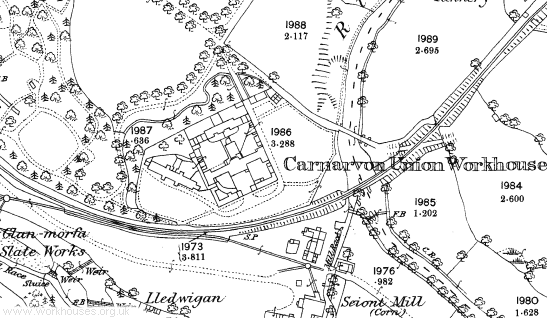
Carnarvon workhouse site, 1889.
The entrance, at the south of the site was, flanked by single storey blocks, presumably including a porter's lodge and receiving wards. The main building was three storeys high in at the front with single storey wings extending northwards at the rear.
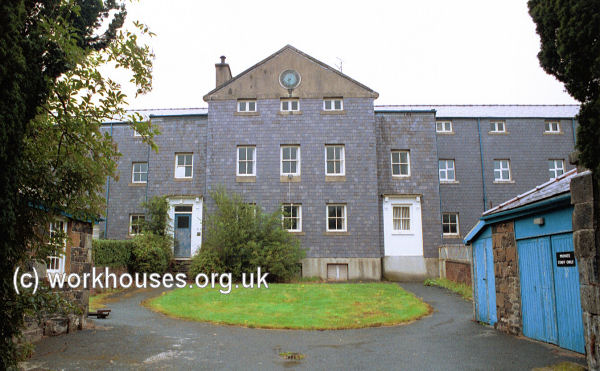
Carnarvon, main block from south, 2000.
© Peter Higginbotham.
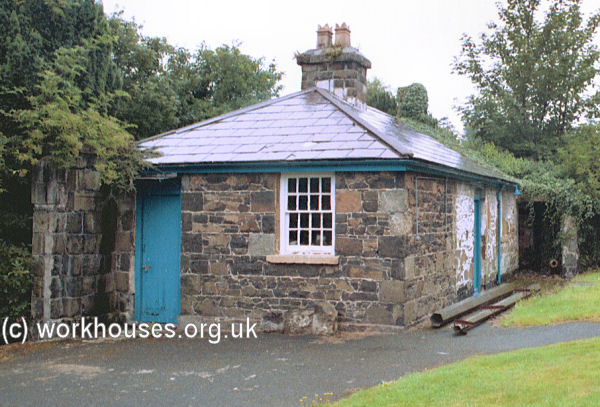
Carnarvon, porter's lodge(?) from the north-east, 2000.
© Peter Higginbotham.
The central portion of the main block protruded at the rear to form a supervisory hub whose windows overlooked all the inmates' yards.
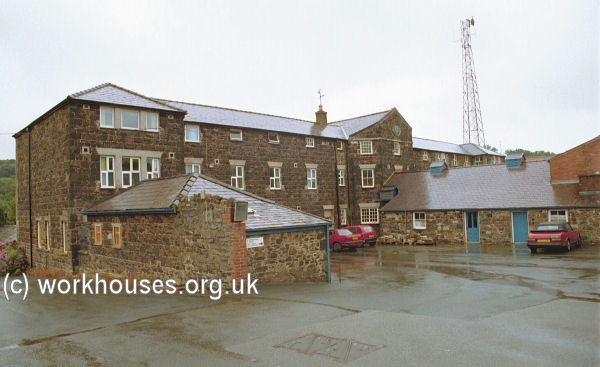
Carnarvon, main block from the north, 2000.
© Peter Higginbotham.
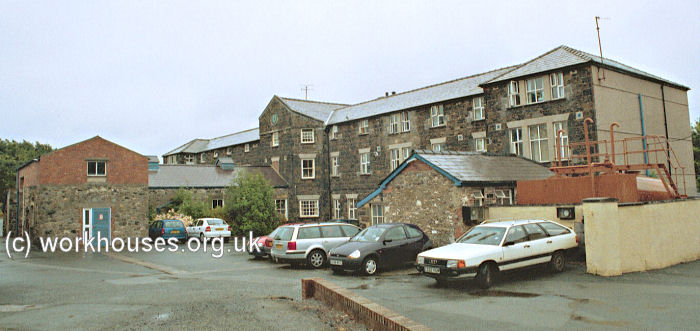
Carnarvon, main block from the east, 2000.
© Peter Higginbotham.
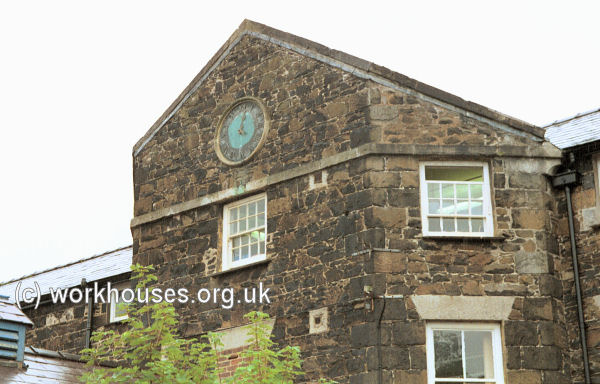
Carnarvon, detail of main block from the east, 2000.
© Peter Higginbotham.
A row of smaller buildings, probably including the original infirmary, lay along the north of the site.
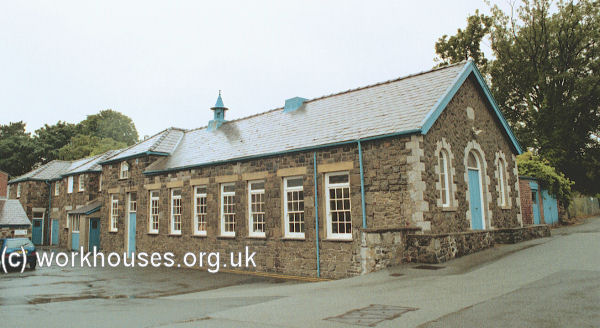
Carnarvon outbuildings from the east 2000.
© Peter Higginbotham.
In April 1881, tenders were invited for the erection of a new infirmary and vagrant wards. The infirmary, placed at the south-west of the workhouse, was designed by Messrs Thomas and Ingleton of Carnarvon.
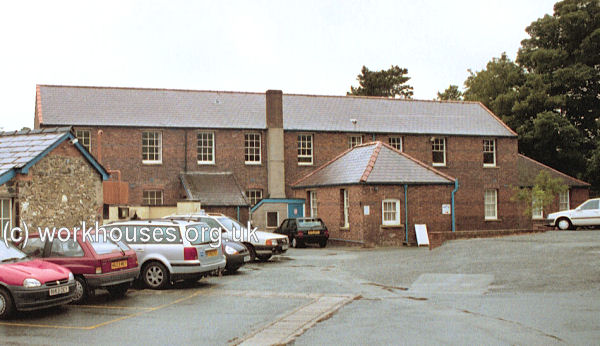
Carnarvon infirmary from the north-east 2000.
© Peter Higginbotham.
On October 12th, 1846, the union's Clerk wrote to the Poor Law Commissioners to seek guidance regarding the serving of refreshments from workhouse stores to the Guardians at their board meetings. Some of the guardians travelled a distance of from twelve to fifteen miles, direct from home. The Clerk enquired whether "the master of the workhouse may supply the Guardians with a basin of soup, and a piece of bread each, in order to insure the attendance of the guardians till the termination of the proceedings of the board." The Commissioners' answer, though sympathetic, was in the negative:
In 1914, the union opened a large new hospital known as Eryri Infirmary. It was located at the north-east of the workhouse and used a typical pavilion-plan layout with separate male and female ward pavilions either side of a central administration block. During the First World War, the Eryri was commandeered for use as a military hospital.
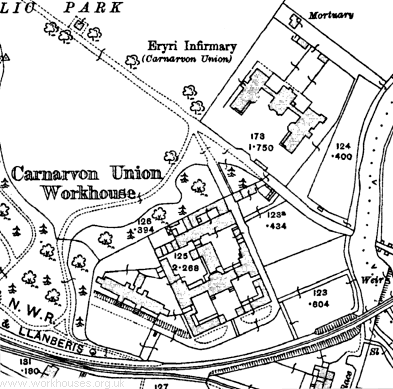
Carnarvon workhouse site, 1918.
After 1930, part of the site operated as Bodfan Mental Home for 'mentally defective' children and part as a Public Assistance Institution. In around 1950, the whole site was merged under the name Eryri Hospital. The workhouse main block, 1881 infirmary and Eryri Hospital buildings are still in use.
Staff
Inmates
Records
Note: many repositories impose a closure period of up to 100 years for records identifying individuals. Before travelling a long distance, always check that the records you want to consult will be available.
- Caernarfon Record Office, Swyddfa'r Cyngor, Caernarfon LL55 1SH. Holdings: Guardians' minute books (1907-29); Births (1872-1902); etc.
Bibliography
- Flynn-Hughes, Cledwyn The Workhouses of Caernarvonshire 1760-1914 (in Caernarvonshire Historical Society Transactions, vol. 7, 1946)
- Lindsay, Jean The Problems of the Caernarfon Union Workhouse from 1846-1930 (in Caernarvonshire Historical Society Transactions, vol. 52-53, 1991-92)
- NEW! Workhouses of Wales and the Welsh Borders. The story of the workhouse across the whole of Wales and the border counties of Cheshire, Gloucestershire, Herefordshire and Shropshire. More...
Links
- None.
Unless otherwise indicated, this page () is copyright Peter Higginbotham. Contents may not be reproduced without permission.


